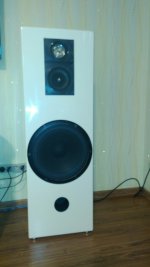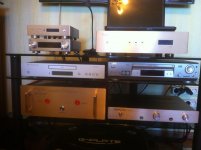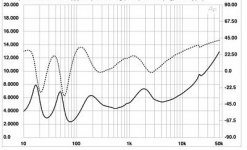@Paroxod
Thank you very much for valuable info.
Please, present us your point of view and your experiences with these advanced speaker protection devices.
I must admit, I have burnt a couple of bookshelf speakers in my garage while testing JLH2003 amplifier. I will rebuild them because they are dear and valuable memory on my first HiFi. But, fortunately, my other "garage" speakers are still working.
For time being I use ordinary Chinese sound protection boards. Tested and work safely.
Thank you very much for valuable info.
Please, present us your point of view and your experiences with these advanced speaker protection devices.
I must admit, I have burnt a couple of bookshelf speakers in my garage while testing JLH2003 amplifier. I will rebuild them because they are dear and valuable memory on my first HiFi. But, fortunately, my other "garage" speakers are still working.
For time being I use ordinary Chinese sound protection boards. Tested and work safely.
Dear Erlend!Dartzeel Clone is really a lousy amp. Can be used for midrange and treble only.
I have measured this clone over a wide range of frequencies and it is exactly as good as the published results of measuring the original. This clone has a ruler-straight response curve over the entire range of interest and more.
Having good treble and midrange is quite a lot. If you miss more bass for pleasant listening, consider using bi-amping. I have used bi- and tri- amping with good results. Then you may add more bass to already great amplifier.
Perhaps, there is another problem with speakers. As you might know, speakers do not have as wide range and require proper configuration with adequate cross-overs. I have found a post #32 might be of interest to you . Read it below:
I have only been listening to this amp for about 10 days. For the break in period its in my living room right now powering a set of M&K satellites. I can compare it to the Sony receiver that normally powered the M&Ks. The receiver is rated 100 watts per channel which is the same as the NHB-108 (100w into 8ohms). The M&Ks never sounded dynamic to me and it didnt really bother me since they were bookshelf sized satellites, I didnt expect them to blow me away. I do have a pair of 8" subs to help them out. Initially I was a bit disappointed with the Dartzeel because the M&K sounded muddy and veiled on the first audition. I quickly realized the subs were now crossovered too high and I had to set the crossover point from 100hz to 50hz and back the gain down a lot. Eventually I even switched the subs off. Suddenly these satellites got a bunch of low end grunt that they never had before. The toms and kick drums were now on point and the speakers became very dynamic, much more musical. The sound is crisp, airy and coherent, I even have imaging now! Before demanding passages were mishmashed with instruments stepping on top of each other, I blamed it on the small living room and the close placement of the speakers to the back wall. Even my wife pointed out the M&Ks sounded like my speakers in my audio room now. So far I can say Im blown away, eventually I want to test this amp in my audio room on a bigger set of speakers and I might even move these M&Ks into the audio room to see if they will sound even better in there.
Well I can't use his comment for anything Berlusconi. His level is what I consider teenage beginner level. I have lots of amplifiers that can do the job alone and no need for biamping. My speakers is nearly second to none with DCA filter components all over. DCA also measured my speakers and designed the filters. Maybe Dartzeel amp measure ok in bas but there is absolutely no kick in the bottom. Best regards from Copenhagen.
there is absolutely no kick in the bottom.
Agree. No amp is perfect for all speakers and music genres. I can understand it doesn't work for you. It works for me chiefly because passive biamping makes life easier for the amps but bass is still far from decent. Thinking seriously of switching to a high nfb amp for the bass channel and leaving the two Dartzeels to deal with mids and highs. There is always a chance this may not work well but still worth trying.
Unfortunately, I have no experience with solid-state protection, I use relay everywhere. My friend bought one of those that I published, I hope he will give feedback after operation. And it seems to me right that for music, different contacts and extra components are not good, but when setting up and experimenting without them, it is impossible, the speakers are more expensive than the rest.
With all due respect, I cannot agree in the absence or low bass of the dartzil. My Chinese clone controls meter speakers where there is a 30cm woofer, so there are blows in the chest. Something is wrong with your amplifiers.
Attachments
Yes, our amplifiers are all broken. Whoever mentioned an absence of low bass anyway? Subjective opinions are always confined within the context of the speakers being driven. Some are much easier loads than others.
Like your opinion and agree. But my system is only 88-89 dB and Low Q. Think the missing feedback is the culprit.
Do amplifiers with low distortion sound Boring??
Does anyone even like an Unmodified Dartzeel NHB 108 anymore?
This thread has more or less talked me out of building one over the course of a year.
Now I just do not know what to build. .
I found a very interesting statement from an Ali seller:
(Amplifier) "L12-2 is mainly used for monitoring and has ultralow distortion, but the lowest distortion does not mean that it may be the best listening amplifier, so it is more suitable for professional users who have very high accuracy requirements for details.
◆This is not a warm-sounding amplifier. If you are looking for a very low distortion amplifier with clean, detailed sound, you will love it.
◆ L12-2 has been used by thousands of users since 2006"
One Pair LJM L12 2 Dual Channels Ultra low Distortion Amplifiers Audio Finished Board and DIY KITS Sound Amplify|Amplifier| - AliExpress
I remember reading that Dan D'Agostino did not care about distortion readings when he designed his latest amplifiers. The same goes for Mr Deletraz. They listen to the Sound. Do Low Distortion amplifiers sound Dry/Boring?
Any comments on that?
Does anyone even like an Unmodified Dartzeel NHB 108 anymore?
This thread has more or less talked me out of building one over the course of a year.
Now I just do not know what to build. .
I found a very interesting statement from an Ali seller:
(Amplifier) "L12-2 is mainly used for monitoring and has ultralow distortion, but the lowest distortion does not mean that it may be the best listening amplifier, so it is more suitable for professional users who have very high accuracy requirements for details.
◆This is not a warm-sounding amplifier. If you are looking for a very low distortion amplifier with clean, detailed sound, you will love it.
◆ L12-2 has been used by thousands of users since 2006"
One Pair LJM L12 2 Dual Channels Ultra low Distortion Amplifiers Audio Finished Board and DIY KITS Sound Amplify|Amplifier| - AliExpress
I remember reading that Dan D'Agostino did not care about distortion readings when he designed his latest amplifiers. The same goes for Mr Deletraz. They listen to the Sound. Do Low Distortion amplifiers sound Dry/Boring?
Any comments on that?
Last edited:
... The same goes for Mr Deletraz. They listen to the Sound. Do Low Distortion amplifiers sound Dry/Boring?
"So you can see that IMD is even less easy to understand and quantify than THD. And how can we appreciate IMD, can we hear it, at what level does it become a nuisance? Well, the first thing we can admit is that it is not musical instruments that generate intermodulation effects, but our own hearing – brain included – that is the cause. Some acousticians say than our internal ear can "produce" intermodulation artifacts at levels between 25 to 40%! Of course the brain then does some necessary "correction".
However, this kind of "correction" cannot be compared with an electronic chain, say the microphone and analysis system. So, we feel very uncomfortable about advancing any IMD value from external origin for which our ear is sensitive. In practice it seems that IMD less than 2% (3 to 5% for THD) is considered as not disturbing, even not audible in a musical context, judging by the Single Ended Triode aficionados or by all the psycho acoustical experiments conducted over the past few decades. By way of conclusion, it appears that IMD, while perhaps more disturbing than THD, remains practically harmless, provided the levels are not outrageously high." - Hervé Deletraz
Mr. Deletraz places more emphasis on so-called temporal distortions (TD). It could also be called a "timing error". Deletraz likens it to "jitter." The extent of this error is not or only barely reflected in conventional THD and IMD measurements. You can find more explanations in the paper below.
Attachments
Dartzeel is one of the least DIY friendly projects on the net. IMO if you want a similarly clear, smooth tube-like sound, choose the ASR Emitter clone or build an APEX B500 (don't be fooled by the fact that it was originally a PA amplifier, actually is a high quality audiophile circuit) or a similar amplifier with simple, fast, linear and precise VAS, such as the Philips AH578. The amplifiers mentioned above have the same DNA, they are easy to build. You will not be disappointed in either.
Last edited:
- Home
- Amplifiers
- Solid State
- Dartzeel amp schematic - build this?



